179
Pre-war

Photo courtesy of the digital collections of the National WWII Museum.
Marine Railway Incident, 1942
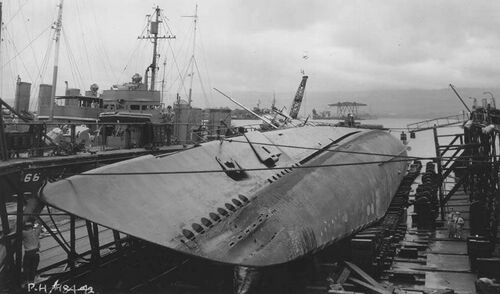
To the left in the photo is the Clemson-class destroyer USS Greene (DD-266). In the far background is the floating derrick YD-25, a fixture at the Pearl Harbor Navy Yard since 1915.
NARA San Francisco photos via Tracy White and Navsource.org.
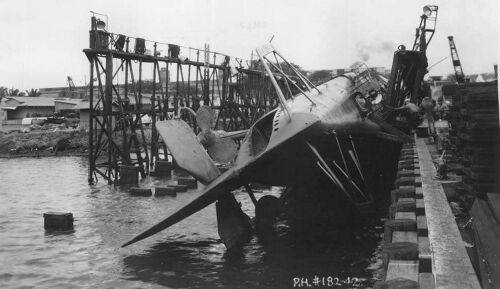
A view from the stern of Plunger, rolled to starboard and leaning precariously against the side of the marine railway. At least one of her aft torpedo tube shutter doors are open. The frame-like structures on either side of the stern are propeller guards.
NARA San Francisco photos via Tracy White and Navsource.org.

A view of Plunger's keel area as she was rolled to starboard on the marine railway. The oval openings near the keel and below the bilge keel are the Kingston valves that close off the bottom of the ballast tanks. In a later overhaul these Kingstons would be removed as unnecessary and the boat would "ride the vents" while surfaced, keeping air in the ballast tanks solely by the vents at the top of each tank. Fleet submarines after the early Gato-class boats would never have the Kingston's installed during construction. Most of the remainder had them removed. Just below the Kingstons are white blocks of zinc attached to the hull. These zinc plates help to reduce galvanic corrosion. They have to be replaced at regular intervals.
NARA San Francisco photos via Tracy White and Navsource.org.

A view of Plunger's stern showing the propeller shafts, support struts, and the rudder.
NARA San Francisco photos via Tracy White and Navsource.org.
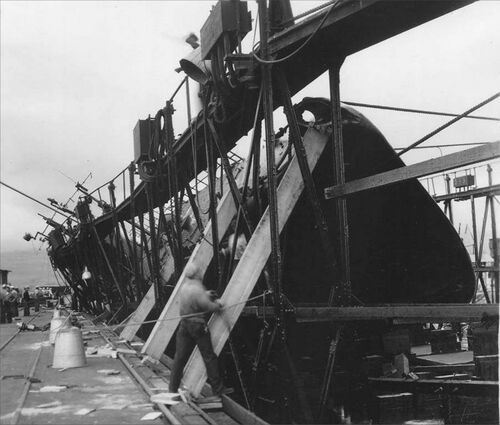
A view from Plunger's bow showing how shoring was put in place to temporarily stabilize the boat until she could be righted. The starboard side of the railway dock was damaged when the Plunger's conning tower fairwater struck it.
NARA San Francisco photos via Tracy White and Navsource.org.
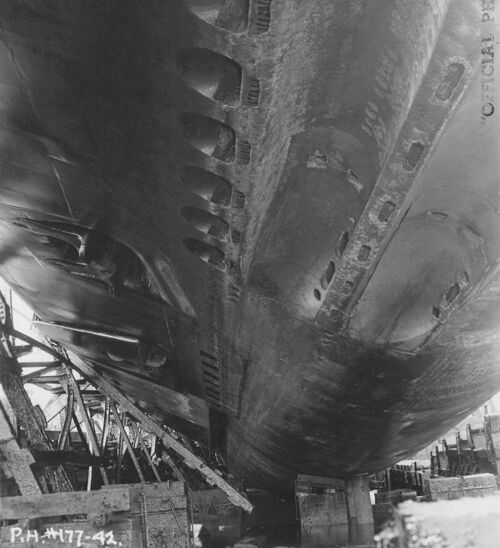
The view from underneath the rolled over Plunger. This incident was a failure of the dockyard engineers to properly place and secure the keel blocks. It can be safely assumed that they were in a hurry given the war situation. It is remarkable that the boat was not seriously damaged and that injuries were slight.
NARA San Francisco photos via Tracy White and Navsource.org.
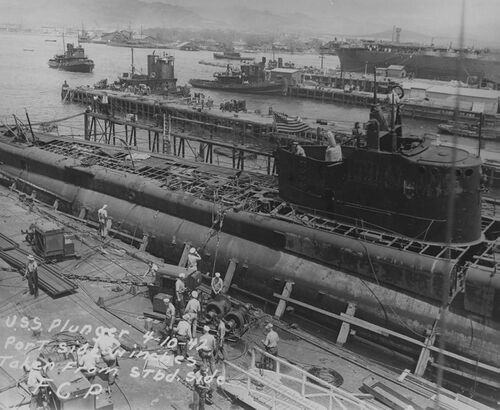
By April 10, 1942, Plunger was back upright and the original work was proceeding apace. Most of her decking and portions of her superstructure have been removed. Note details of her conning tower fairwater and the periscope shears, still unmodified in this photo. The two periscopes have a stepped appearance because #1 scope lets into the control room and #2 lets into the conning tower. On the port side of the shears is a circular Radio Direction Finder (RDF) loop antenna. The odd shaped object on the cigarette deck aft of the bridge covered by a tarpaulin is a water-cooled M2 .50 caliber machine gun, always mounted in port for quick use against attacking aircraft. Note the aircraft carrier in the right background.
NARA San Francisco photos via Tracy White and Navsource.org.
At Midway Atoll, July 1942

Fulton was under the command of CAPT Alexander Dean Douglas, an experienced submariner. Douglas was in command of the USS R-14 (SS-91) in May of 1921 when she ran out of fuel during a search and rescue operation east of Hawaii. Under Douglas' leadership, the crew rigged sails and sailed the boat back to Hilo, Hawaii.
U.S. Navy photo.

A better view of Plunger alongside the Fulton at Midway, July 1942. Submarine tenders are remarkable ships. They are in essence a mobile shipyard and submarine base, capable of performing nearly every conceivable repair needed except for major hull repairs or drydocking. They also carry torpedoes, ammunition, food, and spare parts for the submarine. The tenders were indispensable to the submarine campaign and served in every theater of the Pacific during the war.
U.S. Navy photo.

A closeup of the photo above showing a portion of Plunger's crew lined up on her forward deck. It is possible that they are waiting to set up a stores loading detail, bringing supplies from the tender down the gangplank in the background.
U.S. Navy photo.

Plunger's conning tower fairwater. She has received the equivalent of a Gato-class Mod 2 fairwater modification, which cut away the bulwark around the aft end of the fairwater. This not only lessened the boat's silhouette, but it also gave the .50 caliber machine gun mounted there (covered by a tarp) a much better arc of fire. In a later modification, the covered pilothouse at the forward end of the fairwater would be cut away too.
U.S. Navy photo.
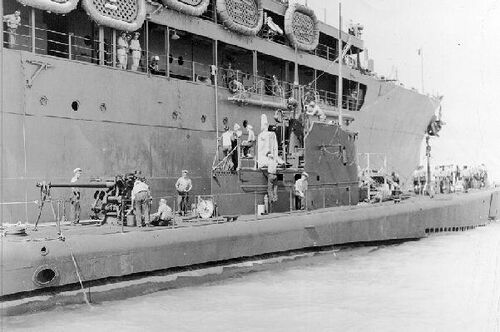
This view from aft gives a better look at the modifications to Plunger's fairwater. At this point she still retains her original 3"/50 caliber Mk 6 deck gun in the aft position. It would later be swapped out for a newer Mk 17 model. The open hatch at the aft end of the fairwater leads down into the crew's mess compartment.
U.S. Navy photo.
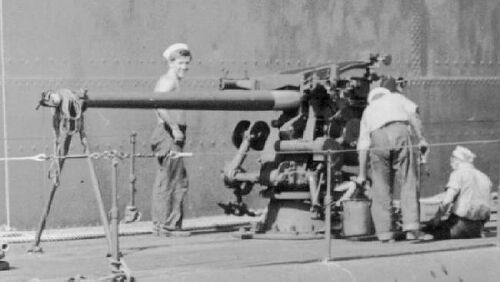
A closeup of the Mk 6 gun. Operational wartime use showed that this gun lacked the punch necessary to finish off targets quickly. Later fleet submarines would receive more powerful 4" and 5" guns.
U.S. Navy photo.
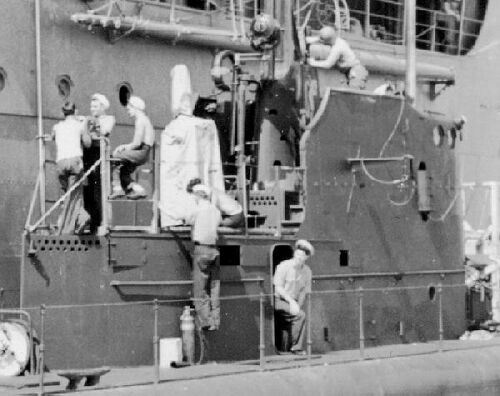
A closeup of the aft end of the fairwater. A Chief is emerging from the void space behind the conning tower, having just exited the conning tower through a watertight door in its aft end. Two sailors are working on a newly installed Target Bearing Transmitter (TBT), located on a frame on the very aft end of the cut down fairwater. A TBT is used to transmit a bearing to a target down to the Torpedo Data Computer in the control room. This allows more efficient night surface attacks.
U.S. Navy photo.
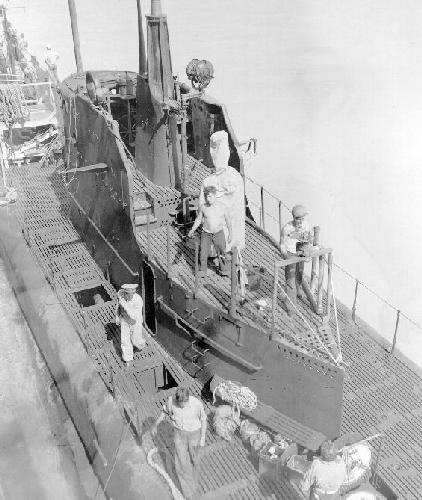
In a view taken from the Fulton, the aft end of the fairwater can be clearly seen. At the top of the photo some plating has been removed from the shear for #2 periscope. To the left the RDF loop antenna is mounted to the port side of the fairwater. Above and behind the tarp covered .50 caliber machine gun is a searchlight/signal blinker. In the right center the newly installed pedestal for the TBT can be seen, next to the sailor in the helmet.
U.S. Navy photo.
Crew Photos, 1943
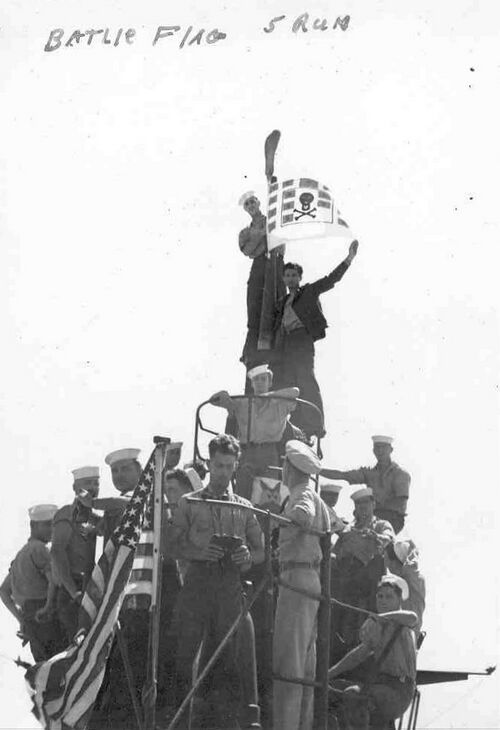
Photo in the private collection of Ric Hedman.
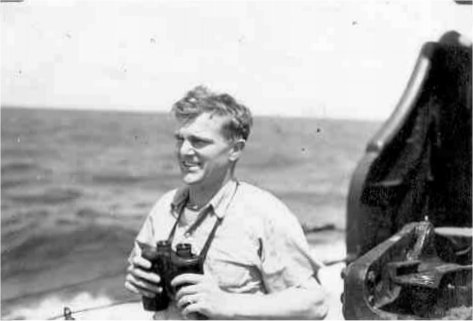
Plunger commanding officer LCDR Raymond H. Bass, known as "Benny" by his friends. Bass was a solid CO and well respected. He is shown here on the cigarette deck during the entry into Pearl Harbor at the conclusion of war patrol number 5.
Photo in the private collection of Ric Hedman.

The Plunger's wardroom in mid-1943. This photo was taken on the cigarette deck looking aft. Plunger has been upgraded with 20 mm guns on this deck, along with a 2nd one on its own mount on the main deck aft, just visible behind the officers. The gun for that mount has been taken below.
Front row, left to right:
LT Art Palm
LCDR R. H. "Benny" Bass, CO
LT William Brown, XO
Back Row, Left to right:
LTjg Bill Smith
LTjg Ed Hannon
LT Quin Pierce
LTjg Tom Oberbeck
A semi-amusing footnote: On a subsequent patrol, LT Brown was wounded by shrapnel during a strafing attack by a Japanese plane while Plunger was rescuing a downed U.S. aviator. Brown's wound was in his posterior. "Weegee" Brown had a reputation as having perhaps the largest rear-end in the Navy. When he received his Purple Heart, a "friend" of his quipped, "It figures. How could the Japs have missed?" Brown fully recovered physically, but his wound followed him around at cocktail parties for many years to come.
Photo in the private collection of Ric Hedman.

Rear Admiral Charles A. Lockwood, Commander Submarine Force Pacific Fleet (COMSUBPAC) pins the Silver Star on LCDR Bass on the deck of Plunger while in Pearl Harbor, 1943.
Photo in the private collection of Ric Hedman.
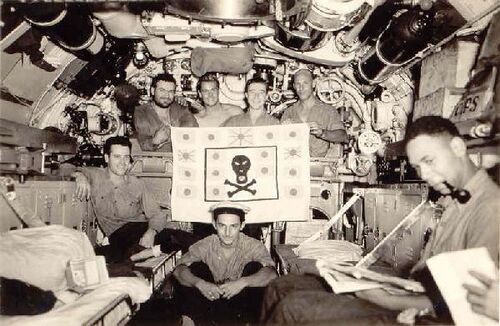
This photo is dated June 21, 1943 and shows some of Plunger's crew posing with the boat's battle flag in the forward torpedo room. The man in the center appears to be wearing a Japanese sailor's hat.
Photo 80-G-72010 courtesy of NARA. A copy is in the private collection of Ric Hedman.
Post War

Photo in the private collection of Ric Hedman.
Page created by:
Ric Hedman & David Johnston
1999 - 2023 - PigBoats.COM©
Mountlake Terrace, WA, Norfolk, VA
webmaster at pigboats dot com
